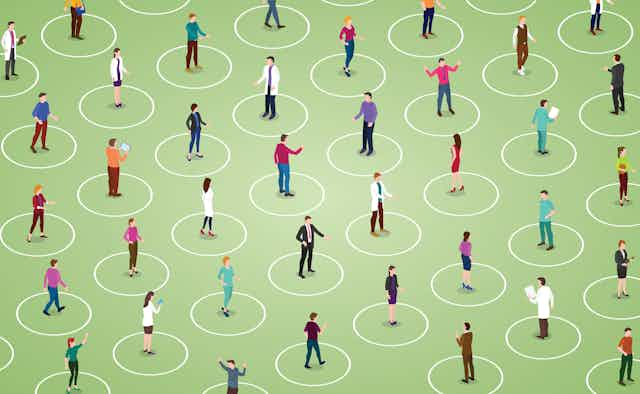For the last few months we have been living in a new and acute state of fear as COVID-19 has threatened and continues to threaten the globe. But living with the virus has also taught us new tricks, pushing us to come up with new ways of how to shop, work, learn, socialise, queue, pray, play, and even how to move and interact with one another.
Still, there is a lingering fear that threatens to outlive the virus itself. How long will it take us to recover from the social distancing that has taken place – this life-saving necessity that has scarred our psyches and bodies alike?

Despite a long tradition of prioritising the mind over the body, it is clear that lessons learned through and with the body are long lasting. Think, for instance, of the enduring social and psychological impact of segregating spaces based on race.
Or even how public spaces can polarise bodies as “them” versus “us” to create a political battleground, as my own research explores. The way our bodies occupy space directly impacts how we act and how we think.
How then will we cope once we are encouraged to reconquer our (confined) spaces: public transport, open-plan offices, factories, building sites, airports, classrooms, concert halls and shopping malls? As our two-metre safety gap slowly evaporates, how will we overcome this new physical embodiment of fear – the fact that any one of us, including ourselves, could be a threat?
Coping with COVID-19
We mustn’t overlook how we make sense – physically and emotionally – of a world affected by a global virus. My research has examined how our embodied use of space – our proximity, our distance, and the boundaries we create between one another, affects us socially, culturally, economically and even politically. Now we are witnessing how our bodies learn to cope in a new world shaped by a pandemic.
Consider how retail spaces have been transformed to safely accommodate our new potentially contagious selves. Quick off the mark, retailers have reinvented how we shop: how much, how often, who with. Thanks to visible cues and courteous policing, they make us aware of our bodies, of other bodies, of how we now occupy space compared with how we did before – without a thought.

In the wake of new pandemic signage and messages, we witness how our retail spaces, public parks and scarcely populated classrooms have become carefully curated spaces that curb our social interaction, pushing us away from one another.
But how will our bodies navigate communal spaces once these protective barriers come down? How will commuters sit easily side by side on buses, trains and planes, without a sense of fear rippling through their bodies at the prospect of a contagious neighbour?
Is our new normal a world where faces are hidden from view, senses dulled by plastic gloves and the possibility of human contact shielded by protective glass? How will our bodies cope? And how will our new fragile – and more sanitised – world cope with all these bodies?
Although there is evidence of how the pandemic affects some people more than others – the elderly and infirm, men over women, ethnic minorities, those on the periphery of society – there is an uncertainty about COVID-19 that makes it particularly frightening. Carriers remain alarmingly generic in appearance and behaviour, and new evidence suggests many may have no symptoms.
The source of our anguish has no gender, no ethnicity, no political agenda, no purpose. It lacks a story, a face, giving the pandemic a universal quality that makes it hard to digest.
Our fear of the bodies of others is nothing new and humanity has a long and lamentable history of singling out some figures as more frightening than others, whether that’s Muslims post 9/11, asylum seekers in the build up to the Brexit referendum, or the ongoing, systemic demonising of black people.
But the universal nature of COVID-19 renders bodies virtually indistinguishable from one another, making us all vulnerable and dangerous at the same time. Rather than being articulated, our fear of COVID-19 is inherently visceral, firmly ingrained in our muscle memory, making our newly acquired fear of each other all the harder to shake off.
Negotiating a new normal
But there is a silver lining. COVID-19 can be seen as a great leveller, encouraging us to acknowledge our own vulnerability and the vulnerability of others, so that we tackle the virus as a united – and equal – front. It is this new way of living, post-COVID-19, that can make us more accountable and more aware of the impact our bodies have on the environment, on the economy, and on each other socially, physically and emotionally.

In this new renaissance, learning through and with our bodies encourages us to see the world differently. Take for instance how the physical inconvenience of being deprived of “free” plastic carrier bags taught us to be more conscientious shoppers and changed our consumption of (at least some) single use plastic in the long term.
As we begin to break free from our confinement cocoons, the notion of a return to “normality” is both an impossibility and a missed opportunity. Professing such gives a false sense of optimism while denying us to the chance of doing things better.
Surviving a global pandemic, both physically and emotionally, is the scar that we should wear proudly, revealing the injury that has both healed and shaped us. Until then, our bodies must continue dancing our new awkward dance.

